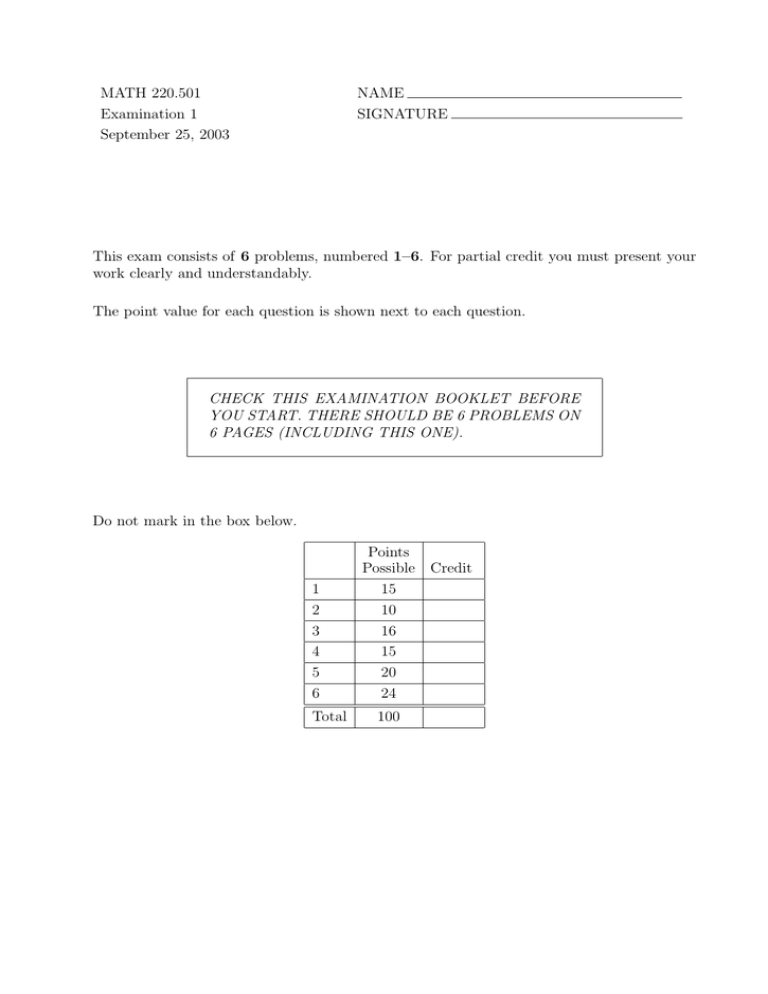MATH 220.501 NAME Examination 1 SIGNATURE
advertisement

MATH 220.501
Examination 1
September 25, 2003
NAME
SIGNATURE
This exam consists of 6 problems, numbered 1–6. For partial credit you must present your
work clearly and understandably.
The point value for each question is shown next to each question.
CHECK THIS EXAMINATION BOOKLET BEFORE
YOU START. THERE SHOULD BE 6 PROBLEMS ON
6 PAGES (INCLUDING THIS ONE).
Do not mark in the box below.
1
2
3
4
5
6
Total
Points
Possible
15
10
16
15
20
24
100
Credit
SIGNATURE
1.
MATH 220
Examination 1
Page 2
[15 points] Determine if the following sentences are statements, open sentences,
or neither. If a sentence is open, incorporate it into a true statement.
(a) a2 + b2 = c2 .
(b) Divide both sides of the equation by 10.
(c) It is impossible for a true statement to fail to be false.
(d) The ratio of the circumference to the diameter is π.
(e) For every real number x, if ax2 + bx + c = 0, then x =
2.
√
−b± b2 −4ac
.
2a
[10 points] Negate the following statements.
(a) There is a y ∈ R so that for all x ∈ R, (x + y)2 = x2 + y 2 .
(b) For all y ∈ R, there is an x ∈ R so that if y > 0 then y = 2x .
September 25, 2003
SIGNATURE
3.
MATH 220
Examination 1
Page 3
[16 points] Let A = {6, 10, 15} and B = {3, 5}. For each of the following statements,
determine if it is True or False.
(a)
∀a ∈ A, ∃b ∈ B so that a is divisible by b.
(b) ∃b ∈ B so that ∀a ∈ A, a is divisible by b.
(c)
∀b ∈ B, ∃a ∈ A so that a is divisible by b.
(d) ∃a ∈ A so that ∀b ∈ B, a is divisible by b.
4.
[15 points] Starting with the initial symbols provided, translate the given statement
into an equivalent statement made of mathematical symbols.
(a) Between any two distinct real numbers there is a third real number.
∀x ∈ R, ∀y ∈ R, if x < y, then
.
(b) The product of two negative real numbers is positive.
∀x ∈ R, ∀y ∈ R,
.
(c) There is no largest integer.
∀n ∈ Z,
.
September 25, 2003
SIGNATURE
5.
MATH 220
Examination 1
Page 4
[20 points] Fill in the blanks of the proof of the following statement:
For every integer n, if n2 is divided by 4, then the remainder is either 0 or 1.
Proof. Let n
.
Case 1: n is even. Since n is even, we can choose k ∈ Z so that
.
Then
n2 =
and so
n2
4
=
,
, and the remainder when n2 is divided by 4 is
.
. In this case, we can choose k ∈ Z so that
Case 2:
. Then
n2 =
,
and so
n2
=
4
Thus, in this case, when n2 is divided by 4, the remainder is
.
.
Therefore, in either case, when n2 is divided by 4, the remainder is 0 or 1, which is
what we wanted to prove.
September 25, 2003
SIGNATURE
6.
MATH 220
Examination 1
Page 5
[24 points] Consider the following 11 statement forms.
(A) P ∧ (P ⇒ Q)
(D)
Q ∧ ¬Q
(B)
(¬Q ⇒ ¬P ) ∧ (¬(P ∧ Q))
(E)
P ∨ ¬P
(C)
((P ⇒ Q) ⇒ Q) ⇒ P
(F)
P ⇒Q
(G) Q ⇒ P
(H)
¬Q
(I)
¬P
(J)
P ∧Q
(K)
P ∨Q
Match up each statement on the left (A–C) with its logically equivalent statement on
the right (one of D–K). Explain your answers.
September 25, 2003
SIGNATURE
MATH 220
Examination 1
Page 6
(Bonus) [4 points]
Recall that a prime number is an integer ≥ 2, whose only positive divisors are itself and 1.
Prove the following statement:
For all n ∈ N, if 2n − 1 is a prime number, then n is a prime number.
September 25, 2003




